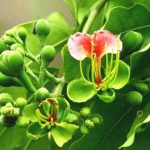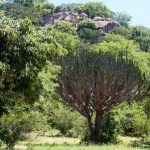TREE LIFE
January 1996
MASHONLAND CALENDAR
Tuesday 2nd January. Botanic Garden Walk at 4.45 for 5 p.m. We will meet Tom in the public car park of the Gardens, and continue where we left off last month. There will be a guard for the cars.
Saturday 6th January. On Mark’s Walk to the Mukuvisi Woodlands we will look at some of the plants that have come up with the rains, meeting in the Woodlands’ car park at 3.00 p.m. The Woodland is situated at the corner of Mutare/Glenara Ave.
Sunday 21st January. Eric and Judy Beachyhead in Christon Bank will be our hosts this month. We have a choice of gentle slopes, level ground or even riverine depending on the state and accessibility of each. The decision will be made on the day. Bring whatever you need to keep dry and warm. Eric and Judy are horticulturists, so in the event of a sudden downpour we are bound to find a vegetable shed close by. Christon Bank has a good variety of tree species and by January the herbaceous plants will be splendid. We meet at 10.00 a.m.
Saturday 27th January. Well into the rains so all sorts of herbs and climbers could be flowering-seeding for Mark’s Walk at Lyndhurst Farm close to Harare.
LONG TRIPS If you are interested in any of the following trips please contact Maureen Silva-Jones.
Thursday 29th Feb. to Sunday 3rd March. RIFA the hunters’ camp at Chirundu. Maximum 30 people. First come basis. Details will be finalized soon
April 5th to 8th Easter. Accommodation for 24 has been reserved at Ezulwini in Nyanga. First come basis.
September 18th to 31st? A trip to Cape Town is being considered to see the famous fynbos. Own transport with a possibility of camping along the way. 20 people. Details later.
MATABELELAND CALENDAR
Monday 1st January 1996. Our usual Social – please phone Ian or Margaret McCausland.
Sunday 7th January. An all day visit to June Davies’ farm at Figtree. Depart from Girls’ College promptly at 8.30 a.m.
Sunday 4th February. Matopos.
A Rare Protea Rediscovered at Nyanga
In 1954, Mr N C Chase, the well-known botanist, collected some specimens of an unknown Protea from the southern end of Chingamwe Estate near Nyanga. The species was collected again by Mr J S Beard in 1956 on the slopes of Mt. Nyangani and was later described by him as a new species, Protea asymmetrica.
The specific name refers to the opening of the flower, which occurs first on the western side of the head, giving it an asymmetrical appearance when it is half open.
Following the publication of Mr Beards’ book The Proteas of Tropical Africa in 1993, a protea grower in the Eastern Districts, Derek Archer, re-found the species on Mt. Nyangani. Later, in correspondence with Bob Drummond, Mr Beard suggested that a search should be made at Chingamwe for Chase’s 1954 location.
And so, on 20th November 1995, a party of interested people, namely Mary Clarke, Derek Archer, Bob Drummond, Maureen Silva-Jones and the Hyde family visited (by kind permission of Chingamwe Estates) the edge of the Chingamwe plateau.
Botanically, the area is extremely interesting with rocks close to the surface preventing it suffering the fate of so much of Nyanga. After an abortive walk to some low rocky hills, we came back along the edge of the magnificent drop into the Honde Valley and quite quickly the first specimens of Protea asymmetrica were seen.
Indeed there were probably hundreds of plants growing along a rocky ridge at the edge of the great drop and down the extremely steep slopes, at an altitude of c. 1850/1900 m. The species is a shrub, branching from the base and achieving 2-3 m in height. No flowers were seen, but there were plenty of old heads. Associated shrubby or woody species were: Erica sp., Chrysanthemoides monilifera, Anthospermum ammannioides, Dodonaea angustifolia, Myrica sp., Tephrosia sp., and Widdringtonia nodiflora.
Later, we drove along a track near the edge of the plateau and came across a further colony of the species. It is very pleasing to be able to report that the species still survives in fair quantity on the Chingamwe Plateau.
-MARK HYDE
Marussino Farm 19th November, 1995.
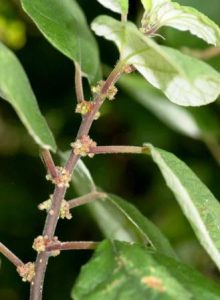
Pouzolzia mixta. Photo: Bart Wursten. Source: Flora of Zimbabwe
Nearly a year has passed since the society clambered through the peaceful jumble of boulders in this really picturesque spot and several thousand years after the Bushmen left their superb tapestry of paintings on the solid walls of granite. The stillness of the morning was broken only by the aviary of bird calls with a particularly strange harsh cry from a pair of chunky Broad-billed Rollers pointed out by Richard on a bough of a very dead Pericopsis angolensis. A curious sight all through the kopjies prompted the question ‘who has eaten the Pouzolzia?’ referring to Pouzolzia mixta where the grey stringy bark has been bitten into and then ripped away. John Bingham noted that the tooth marks were large and blunt suggesting a herbivore.
A water stain from the previous shower of rain appeared to be edging closer to the painting; fortunately the main mural is safely in the cleft with an owl for company. Kenneth Haxen, smaller and fitter than the rest of us, wiggled into the deepest corner in search of bones and skulls while we had another look at the little ‘dog’ and other figures. Perhaps the foliage of Ficus thonningii and Maytenus undata clustered outside the crevice kept the conditions just right especially for the white pigments which seem to be the most easily damaged. Another group of paintings on a nearby cave entrance depicted a number of (dare I say it – hairy chested!) females or was it purely something as simple as necklaces? Other figures carrying arrow quivers were depicted but was the man with a tailless Rhino on his head some ancient joke? The cave, deep and damp held in its gloom some rather interesting bats and something else too – a group of wasps winding up for action!
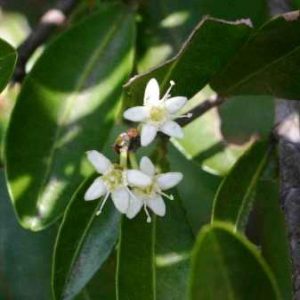
Erythroxylum emarginatum. Photo: Bart Wursten. Source: Flora of Zimbabwe
Leaving the insects to their cave we looked at Diospyros natalensis and both reaching maximum size, Erythroxylum emarginatum with the nick in the leaf and what appeared to be a young Pappea capensis with its typically serrated leaves. An epiphytic orchid hanging over a rock face formed the ultimate nesting site for a small colony of Red-headed Weavers, the shaped nests securely attached to the growing tip of the plant. A few white rosettes of petals caught our attention along with the long spurs but all attempts to have a closer look were thwarted by the steep rocks.
In almost every crevice the pale yellow snaking trunks of Ficus glumosa, the rock splitting fig, eased their way over the rocky obstructions, supporting crowns of stiff hairy leaves. After counting 20 of them sanity prevailed and a mere tick was placed on the Tree Card. The idea of measuring one of them using Meg units was abandoned as the trunk was alive with VERY active ants! The other prolific species Brachystegia glaucescens appeared throughout on the rocky surfaces making a wonderful background for the balancing rocks near the beacon. The climb to the beacon involved some clambering between steep rock faces and careful plodding through the deep leaf mould when a convenient trunk appeared and looked ideal for a stop until a warning shouted from Phil – ‘Tree Nettle’. Indeed Obetia tenax looked unpleasant with the trunk and leaves covered in short stinging hairs and anything tackling this plant requires courage! This is a member of the Urticaceae family which we only see occasionally, kopjies such as these being a typical habitat. A stone’s throw from the summit and its beacon, Kenneth and I stumbled on a group of dozing Bush pigs, dozing in the humid afternoon under a thicket of Grewia bicolor. Perhaps the snapping of a stick or a sweaty scent, but two sudden sharp snorts shook the group into a mass of grey activity hurtling downhill. I wonder who got the greatest surprise, the pigs, the two of us or the wretched Piet My Vrou now silent after hours of incessant calling?
Some of the larger trees growing within the kopjie were Zanha africana, Kirkia acuminata, Erythrina latissima oozing out from the rocks, Sterculia quinqueloba with large pink boles, Parinari curatellifolia in all shapes and sizes, Lannea discolor and a solitary Terminalia stenostachya. Some of the Englerophytum magalismontanum (Bequaertiodendron) were found to have the same fluted trunks that intrigued us at M’torcha in September. And with the first falls of rain the rampant climber Dioscorea sp. with its thorny stems and large heart-shaped leaves, had already begun its summer advance into the overhanging branches.
Once again our most grateful thanks to Gary and Sandie for a wonderful day and for those of you who puzzled over the group of white faced antelope in the reserve, the species is Blesbok.
-Andy MacNaughtan
FIRE-DEPENDENT PLANTS
A recent issue of Wildlife Zimbabwe contains a note on a fire-dependent plant, Iliamna corei, Peter’s mountain mallow (family Malvaceae), which was saved from extinction in Virginia, USA, by a prescribed burning programme. This might seem strange, because we are generally fire-protection conscious, and regard veld fires, bush fires, and forest fires as nothing but destructive. In actual fact, there are many trees that depend for their very survival on periodic fires, and I wonder how many of our indigenous species have a hard time because of fire¬ suppression policies.
Many pines are to a greater or lesser extent fire-dependent for regeneration or for protection from invading broad-leafed species. Pinus banksiana (jack pine), which covers large areas of Canada and the north-eastern United States, has cones that remain closed for 10-25 years or more until a forest fire sweeps through, opening the cones and releasing the seed. In the south-eastern United States nearly all the pines are either pioneers or secondary species in the ecological succession, and in the ordinary course of events they would be invaded and ousted by broad-leafed trees and shrubs. But fire, whether accidental or planned, keeps the broad-leaved species under control, and so allows the pines to survive.
A number of fire-dependent tropical and subtropical pines have developed a self-protection mechanism for surviving fire in their earliest years by going into a “grass stage” soon after germination. In this state the plant looks for all the world like a thick tuft of grass; coarse secondary needles are produced very rapidly, and these form a dense protective cover around the main bud, preventing fires from damaging it. The grass stage may last from 18 months to 6 years, and then fairly rapid height growth begins. Species exhibiting a grass stage that have been introduced into Zimbabwe are Pinus palustris (longleaf pine) and Pinus elliottii var. densa (South Florida slash pine) from the south-eastern United States, Pinus michoacana (Michoacan pine) from Mexico, and Pinus merkusii from mainland Southeast Asia. Species with a short-lived, semi-grass stage (probably also fire related) are Pinus caribaea var. caribaea from Cuba, and Pinus merkusii from the Philippines (Pinus merkusii from Sumatra does not have a grass stage at all).
Other pines have the ability to coppice strongly after having been cut back by fire, e.g. Pinus echinata (short-leaf pine) and Pinus serotina (pond pine) from the south-eastern United States, Pinus leiophylla and Pinus oocarpa from Mexico and southwards into Nicaragua.
Fire is a most important factor in the ecology of nearly all eucalypts. Only rarely (e.g. Eucalyptus torelliana, cadagi) are eucalypts able to regenerate from seed under canopy, and so practically all species, but more especially the tall forest trees such as Eucalyptus regnans (mountain ash), are dependent on fire to turn over the generations under natural conditions. Periodic major fires destroy the old-growth forests and create conditions for a new generation of trees to spring up from seed.
-LYN MULLIN.
Botanic Garden Walk: 5th December 1995
Today we moved on to the subfamily Papilionoideae of the Leguminosae.
This subfamily has the very distinctive ‘pea flower’ with a usually + erect petal called the standard or banner, two parallel petals below (wings) and below, two further petals, often partly or completely fused, meeting at an angle like the keel of a boat (the keel-petals). Stamens are usually 10, often with 1 separate from the other 9.
In general, the leaves are compound, indeed usually imparipinnate, but these may be reduced to 1 leaflet and appear simple. The leaflets are sometimes strictly opposite but more commonly are sub-opposite or alternate. Stipules are generally present where the petiole of the leaf meets the stem and each leaflet may also have a small stipule (known as a stipel) where the leaflet meets the leaf rhachis.
These features are well illustrated by the genus Lonchocarpus. Four species occur in Zimbabwe. Three have imparipinnate compound leaves and one, Lonchocarpus nelsii, has simple leaves. Lonchocarpus nelsii has stipules at the base of the petiole and a pair of stipels at the base of the blade, thus perhaps betraying its compound origin, and indeed compound leaves with up to 5 leaflets can occur. It is a species of Kalahari sand occurring only in the west of Zimbabwe.
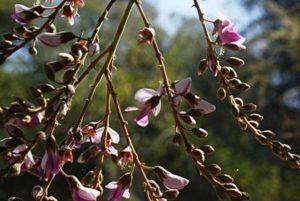
Lonchocarpus bussei. Photo: Mark Hyde. Source: Flora of Zimbabwe
Of the others, Lonchocarpus bussei and Lonchocarpus eriocalyx have relatively large numbers of leaflets (generally more than 5) whereas Lonchocarpus capassa has usually 3-5 with the terminal leaflet markedly larger than the others.
Lonchocarpus capassa is the common Rain Tree, occurring in a wide variety of habitats, including riverine, vegetation and on termite mounds.
Lonchocarpus bussei is a species of rocky outcrops and of the Jesse, occurring at low altitudes. Tom mentioned that Lonchocarpus eriocalyx has been found to be very difficult to grow in the Gardens and only one very small plant was found In Zimbabwe, it occurs in the North and West.
A closely related genus is Pterocarpus. In (yellow) flower was Pterocarpus brenanii with its extraordinarily large stipules and relatively large leaves. It grows in the Zambezi Valley.
Another low altitude species, often occurring in riverine vegetation, on rocky outcrops and in the jesse, was Pterocarpus antunesii ssp. lucens. The trees had been covered in yellow flowers, like a yellow cloud as Tom remarked, but was just a bit past its best on our visit.
Pterocarpus rotundifolius ssp. polyanthus has many more leaflets and occurs at lower altitudes than our ssp. rotundifolius found around Harare. I must admit that I confused it with Xeroderris stuhlmannii, another closely related species. Ssp. rotundifolius is a species of the savannah woodlands, usually in higher rainfall areas.
Finally, the Mukwa or Bloodwood, Pterocarpus angolensis with its rough outer bark and reddish underbark. Trees are heavily used for medicinal purposes and this specimen in the Gardens showed signs of having been used for this purpose.
Once again, thanks to Tom for a fascinating walk.
-Mark Hyde
Thanks for the responses to Benedicta Graves’ query about the derivation of the Tambourine Dove’s name.
1) from Karl van Laeren:-
Tambourine Dove Turtur tympanistria
MK Rowan, the author of The Doves, Parrots, Louries & Cuckoos of Southern Africa cites Benson on the origin of the common name. Tympanistria in Greek mythology refers to a priestess of Cybele who used drums or tambourines. The reference is to the rhythmical throbbing of the call uttered in a mournful cadence very similar to that of the Emerald Spotted.
2) From Ian Riddell.
The Tambourine Dove’s name derives from its nominatio, Turtur tympanistria, the specific name alluding to its call. This is much akin to the Green-spotted Dove and you can sometimes hear it (or both) calling in the Forest sections of the Botanic Gardens. Tympanistria invokes thoughts aural since the tympanum refers to the cavity of the middle ear and sometimes eardrum (more correctly the tympanic membrane). From the Greek tumpanon or Latin tympanum meaning a drum or timbrel – a tambourine. Which leads to timbre… not forgetting a tympanist, one who plays a (kettle) drum… a good place to stop!
Anyway, to get back to timbrels; these were played by the priests/priestesses of Cybele (pick your pronunciation) in rites to the Phrygian mother-goddess, also being Rhea in Greek myth, the wife/sister of Cronus and mother of – amongst other gods – Jupiter.
Phew.
Terrestrial orchids: 18/11/95
The area adjacent to the Sculpture Garden proved to be fascinating with seven Eulophia species being noted. The main identifying features of the genus are to be found in Tree Life 190. To our surprise some of the species were locally abundant and to summarize we saw an interesting mix of large and small flowering species, namely 3 large flowering, 3 small flowering (one already in seed) and one saprophytic species.
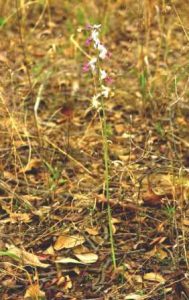
Eulophia livingstoniana. Photo: Bart Wursten. Source: Flora of Zimbabwe
First we looked at Eulophia livingstoniana, growing in abundance (50 flowering plants) on a very small patch which was a recently burnt patch with the blue flowering annual Dolichos occurring nearby, possibly pollinated by the same insect species. Bush fires are known to have a stimulating influence on the flowering of certain species. The flower spike of this orchid is up to 70 cm high with the sepal and petals being pure white to pink (the 3 sepals being sharply deflexed) and the lip being a range of colours from pink through to dark purple. The tubers which support these plants are shaped like plump sausages and grow in chains, often occurring at a depth of some 10 cm.
Eulophia cucullata is one of the most common and widespread species and can be found on vlei fringes, Msasa woodland, grassland and as a re-coloniser on road sides. The flowers are highly visible where colours vary from soft pink to deep maroon and the 3 sepals are small and deflexed, greenish to maroon. The most characteristic feature is the big, blunt yellow spur.
Eulophia speciosa was also found in abundance, this being the most common and widespread terrestrial orchid in Africa ranging from Natal to southern Arabia.
Eulophia speciosa tends to grow in medium-large colonies but it appears normal for only 10% to 20% of the plants to be flowering. The flowers are bright yellow in a very open structure with 3 very small sepals, deflexed and green in colour.
A few scattered specimens of Eulophia rolfeana were noticed, but are not easy to find as the plants are only 15-20 cm in height. The flowers are yellowish-brown and the hairy lip is an interesting structure.
Eulophia actilabra was also noticed in this area, but had flowered in early October and the seed capsules were opening giving the opportunity to see the incredibly small orchids seeds, so tiny in fact that they resemble dust!
Another of the small species found higher up the kopjie in predominantly ironstone soils is Eulophia venulosa, a species that occurs in small colonies. The stem is very slender and 20-40 cm in height. The main feature of this species is the large (for its size) white hairy lip with maroon sepals curled backwards making an attractive flower. However, a lens is needed to see the strong veins in the inner lip. The genus Eulophia contains a few saprophytic species, i.e. plants without leaves. A large and typically scattered colony of Eulophia nyasae was found. Although the flowers are attractive the 30 cm high robust flower spikes always appear rather ‘untidy’. A complex rooting system was unearthed by Werner to demonstrate the short roots and also the rhizome-like structure following the pockets of soil between the banded ironstone.
Very many thanks to Werner and Virginia for a fascinating afternoon learning bout and identifying some of our terrestrial orchids we may see on our walks. Another orchid walk in the second half of the rainy season is planned, probably in February for a look at Habenaria and Satyrium.
-A MacNaughtan
I was interested in Mark Hyde’s spelling of rhachis in his write up of the Botanic Garden Walk in Tree Life No. 188 October 1995 especially as I had conducted that walk and as I have always spelt rachis without an ‘h’. I just think that it is user-friendlier! It is a controversial subject and resulted in some notes in Tree Life No. 27 way back in May 1982. That was over 13 years ago and may bear repeating.
“Recently I realised that what I have always spelt rachis Flora Zambesiaca spells rhachis.
Brian Best started the research which Paul has completed and now comments:-
Rachis vs. rhachis
There is no doubt that correctly, it should be spelt rhachis but has been used so commonly without the first ‘h’ that this has become an equally accepted alternative. In fact Henderson’s Dictionary of Scientific Names gives all the information under rachis and looking up rhachis refers you back to rachis.
William T Stearn’s Botanical Latin gives the following fascinating explanation upholding my first sentence. In the Greek alphabet a backwards comma above a small letter means that the word originally started with an ‘h’ and is the rough breathing sign (spiritus asper). A small letter with nothing above it indicates the smooth breathing sign (spiritus lenis) and means that the word does not have an ‘h’ in front. I refuse to complicate the issue by explaining the upside-down, back-to-front, inside-out apostrophes and commas that appear in front of the capital letters and which all mean different things. And please note that all the apostrophes, commas, quotes etc. that I have used in this article mean only what they usually mean.
To continue; the small letter sign for ‘O’ or omega when used in the word oros, meaning time, has a backwards comma over it so the word should be horos. This is acknowledged in the English words hour, horoscope, horology etc. the Greek letter ‘r’ is written like a ‘p’ (how difficult can you get?) and when used for rachis has a backwards comma over it. This means that it should be hrachis which, being unpronounceable becomes rhachis, meaning spine, backbone, ridge. This letter is responsible for words such as rhizome, rheumatism and rhythm but has equally been corrupted without the ‘h’ for radish, rose and rachis.
To wax lyrical in the Best fashion:
When learning trees in Greek, ‘H’ forbid,
The mHidrib and spHine and the bHackbone did
Teach you just enough so that you knew to miss
The first of the Haitches in the re-Hay-chis.
NB. Stearn’s book does not refer to a little letter as I have done for the sake of clarity but to a little character which I thought might be confusing.
PCP
-Meg Coates Palgrave.
HAPPY NEW YEAR
ANDY MACNAUGHTAN CHAIRMAN


